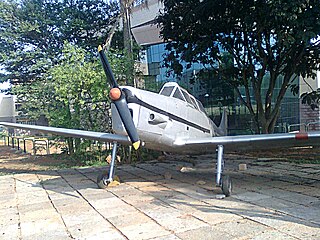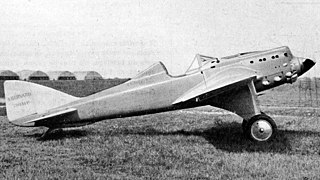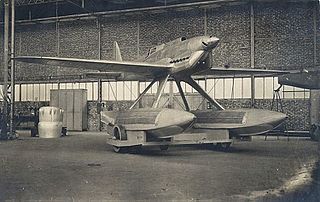
The Caudron C.450 and C.460 were French racing aircraft built to participate in the Coupe Deutsch de la Meurthe race of 1934.

The Farman F.500 Monitor was a 1950s Franco-Belgian two-seat training aircraft.

The Farman F.70 was a 1920s French passenger and mail transport aircraft designed and built by the Farman Aviation Works. It was a smaller counterpart to the company's popular F.60 Goliath. The F.70 was an unequal-span two-bay biplane with a wooden fuselage and was powered by a Renault 12Fe piston engine. The pilot was seated in an open cockpit behind the nose-mounted engine. Behind the open cockpit was a cabin for four passengers or freight.

The Farman F.430 was a 1930s French light transport designed and built by the Farman Aviation Works. Two variants with different engines were known as the F.431 and F.432.

The Fairchild 22 Model C7 was an American two-seat touring or training monoplane designed and built by the Kreider-Reisner division of the Fairchild Aircraft Corporation at Hagerstown, Maryland.

The HAL HT-2 is an Indian two-seat primary trainer designed and built by Hindustan Aeronautics Limited (HAL). The HT-2 was the first company design to enter production in 1953 for the Indian Air Force and Navy, where it replaced the de Havilland Tiger Moth. The HT-2 is a low-wing cantilever monoplane with a fixed tailwheel landing gear. Powered by a 155 hp (116 kW) Cirrus Major III piston engine, the aircraft has enclosed tandem cockpits with dual controls. Apart from military use, the aircraft was also used by Indian flying schools.

The Potez 53 was a French low-wing enclosed cockpit single-seat cantilever monoplane racing aircraft built by Potez to specifically to compete in the 1933 Coupe Deutsch de la Meurthe race, which it won outright.
The Caudron C.510 Pélican was a 1930s French air ambulance or touring monoplane. Designed and built by Caudron and based on the earlier Caudron C.282/8.

The Bernard 20 was a 1920s French single-seat monoplane fighter aircraft designed and built by the Société des Avions Bernard. Originally displayed as a mock-up at the 1928 Paris Air Show it was a low-wing monoplane based on the Bernard V2 racer. The prototype powered by a 400 hp (298 kW) Hispano-Suiza 12Jb inline piston engine first flew in July 1929 from Orly. With its racing inheritance, in 1930 the aircraft flew at a speed of 280 km/h (174 mph). With the lack of interest by the French authorities for monoplanes the project was abandoned after 18 months of test flying.
The Caudron C.480 Frégate was a French three-seat touring monoplane designed by Maurice Devlieger and built by Société des avions Caudron.

The Farman F.370 was a French single-seat racing monoplane designed and built by the Farman Aviation Works for air racing.

The Bréguet 890 Mercure was a late 1940s French cargo and passenger transport aircraft designed by Bréguet Aviation. Three variants were produced including a military variant called the Mars but none entered production.
The Farman F.280 was a three engine, cantilever wing monoplane designed in France as a mail carrier in the early 1930s. Underpowered and slow, only two were built and briefly used.

The Bernard H.V.220 was a 1930s French racing seaplane and the last attempt by Bernard compete in the Schneider Trophy race. Delays caused by engine problems meant the aircraft was abandoned and never flown.
The Blériot 106 was a 1920s French cabin monoplane designed and built by Blériot Aéronautique. First flown on 15 July 1924 the 106 was a single-engined shoulder-wing monoplane powered by a 480 hp (358 kW) Renault 12Jb inline piston engine. The pilot sat in an open cockpit behind the engine and an enclosed cabin had room for six passengers.

The Caudron C.362 and the almost identical C.366 were single-seat racing aircraft built in 1933 by Caudron to compete in the Coupe Deutsch de la Meurthe competition.

The Caudron C.430 Rafale was a fast, two seat French touring monoplane. Soon after its first flight in 1933 it set an international class speed record.
The Delage 12 CEDirs was a French racing aero-engine designed and built especially to power the Kellner-Béchereau 28VD for racing in the 1933 Coupe Deutsch de la Meurthe air races.

The Kellner-Béchereau 28VD was a French racing aircraft built to compete in the 1933 Coupe Deutsch de la Meurthe. Engine failure and damage sustained in the consequent emergency landing prevented the 28VD from participation in the race.
The Caudron C.360 was a French racing aircraft built by Caudron in the early 1930s to compete in Coupe Deutsch de la Meurthe air races.
















